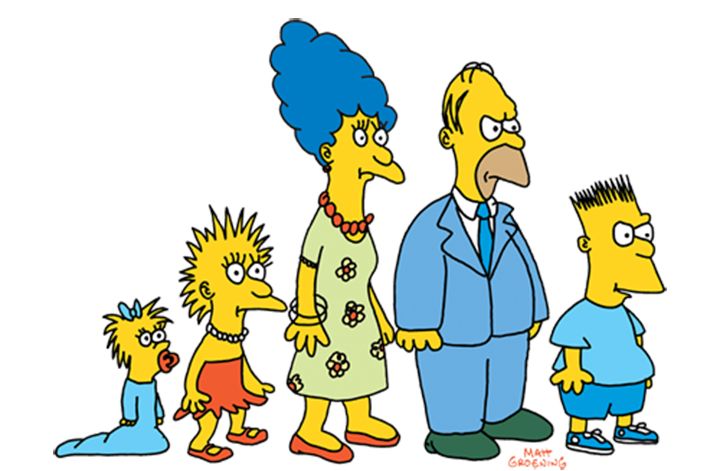
When the Simpson family first appeared on television ― all the way back on April 19, 1987 ― their yellow bodies with odd hair surely seemed novel. Now 30 years later, Homer, Marge, Bart, Lisa and Maggie are positively quotidian.
After graduating from a recurring sketch on “The Tracey Ullman Show” to a full-fledged series “The Simpsons,” this family became a guiding compass for countless other television programs, perhaps at the cost of forgetting how revolutionary it felt in its early years.
A true testament to the show’s greatness, however, is how much this on-screen family inspired pop culture outside of the television space.
The Simpsons have become more than television characters, but masterpieces of American culture that artists have wanted to parody, break down and build up into something new. Below are a few of the more amazing and strange jokes and art projects from recent years that wouldn’t exist without this beautifully peculiar family.
The karaoke room that offers the two-word theme song.
Starting with the least strange and arty of this list, there’s a karaoke bar in Portland, Oregon (because of course), that offers “The Simpsons” theme song as an option.
A former writer for the show, Bill Oakley, happened across the option and shared a picture of the karaoke screen on Twitter. The photo immediately went viral.
Oakley told the full story to HuffPost over an email:
I was at karaoke with my family and my kids. We go to a place in Portland called Voicebox where you get private rooms. I was looking through the section called “TV Theme Songs” which is stuff like the “Addams Family,” “Brady Bunch,” etc. and saw that they had “The Simpsons.”
I couldn’t believe it.
I ordered it up and it played and I was amazed.
I did not actually sing it, sadly, because our time was up and we were vacating the room but I did manage to snap that photo. I tweeted it about one minute later.
The music genre, “Simpsonwave,” that actually got popular.
This artistic offshoot takes a bit more contextual explaining.
On Facebook, there’s a whole community of people who create jokes about “The Simpsons” in a style called “shitposting.” You don’t really need to know what that is, but basically the jokes are often darker and weirder than what would actually ever appear on “The Simpsons.”
In any case, one of these community members, Lucien Hughes, decided to start combining video clips from “The Simpsons” with an electronic music genre called “vaporwave” ― creating what would eventually be deemed “Simpsonwave.” Hughes wasn’t the first to make such a combination, but he arguably popularized the nascent “form.”
Hughes’ “Simpsonwave” videos have earned millions of views on YouTube in just about a year.
Here’s Hughes talking to Pitchfork about what appealed to him about making these videos:
Vaporwave and its associated sub-genres go hand-in-hand with “The Simpsons” because of the combined hit of nostalgia. “The Simpsons” is pretty unique in that it’s something that almost everyone born between the late ’80s and early ’00s grew up watching. Vaporwave is very much about creating an atmosphere of nostalgia, so I feel “The Simpsons” just perfectly fits the whole aesthetic.
Below is arguably the first Simpsonwave video.
The obsessive collection of bootleg shirts.
As with any popular cultural icon, “The Simpsons” has begotten countless knockoff merchandise. That by itself isn’t all too impressive.
More cool is just how popular a curation of the Bart bootlegs alone has gotten.
The Instagram account, bootlegbart, has gained tens of thousands of followers pretty much simply from posting obscure off-brand Bart T-shirts.
In 2014, the man behind the account spoke to Vice about the decision to take on this documentation project:
I was seven in 1990, and like most kids around the world, I loved “The Simpsons.” In addition to Bart shirts, I had bootleg Roger Rabbit [clothes] that my mom used to bring back from the market. I always found them funny, with the colors all mixed up. I remember going to Western International Market and seeing the Bart Marley shirts.
In 2003 I got myself a couple of Bootleg Bart shirts for a laugh. Whenever friends or family went on holiday and asked if I wanted anything, I would always say “a Bootleg Bart shirt.” I was introduced to social sites and thought it would be cool to start up my own little page sharing my shirts and other bootleg “Simpsons” images that I had found. I wanted to make a place online where people could go and reminisce, have a laugh, and remember a time when “The Simpsons” was brand new.
The successful artist who associated himself with the show.
More than 1 million people follow the art work of “TheSimpsonsArt” on Facebook, a page that has the tagline, “Simpsons pictures that I gone and done.”
On the surface, the art posted on this page barely has anything to do with “The Simpsons” except for reaching a community of fans that can appreciate what the Fox cartoon’s current pop culture significance. The show may no longer be considered cutting-edge, but it is ubiquitous and towering. The pieces on this Facebook page usually have a similarly towering, but inherently uncool pop culture inspiration (such as Shrek or Thomas the Tank Engine) but offer bizarro, updated versions of these mammoth icons.
That said, sometimes there’s no pop culture cornerstone and the artist just presents that bizarro take on a mundane aspect of life ― still signing the work “Simpsons artist.”
Here is a quote from the artist talking to the publication Crack in the Road about first experiencing the show in their youth.
I was 5 when the Simpsons went on the telly and I just used to watch it because I wasn’t supposed to go outside. Once I watched the videos I would draw them on my paper and make them talk.
The fan-created alternate opening that twists all that’s familiar.
Wrapping this list up is an homage to the opening sequence with David Lynch-vibes.
The artist Yoann Hervo planned to participate in an animation project to commemorate the show’s 25th anniversary, where various animators would write and create a mini story of their own as though it were in “The Simpsons” universe. Ultimately, Hervo decided it was too hard to top the original’s writing without seeming derivative, and instead went in a much different direction to create this amazing alternate opener.
In an email to HuffPost, Hervo explained the thinking behind his short:
Many animation directors have already practiced this exercise [of creating a new opener]. It’s similar to adopt a Jazz standard in a way…
The idea was to keep the structure of the opening and its dynamic pace ― all the rest of it (tone, action, graphics, etc.) is more malleable and leaves room to interpretation.
I’ve tried to deconstruct everything ― to reach to something more chaotic: changing order of shots and their speed; getting a random art direction for every sequence and an experimental theme. With this conception I lost the essence of “The Simpsons” opening ― in addition to losing the usual audience of the series.
That said, I’ve withdrawn the most pleasant part of the opening, the climax of every Simpsons fans: the couch gag. I thought it was a bit excessive to end on a final gag while the whole opening was a joke. It’s funnier though ― ending on nothing ― an empty couch. It was more about telling a joke with no punchline: the audience is waiting ― nothing happens ― and everyone is frustrated ... a bit like in the real life in a way.
